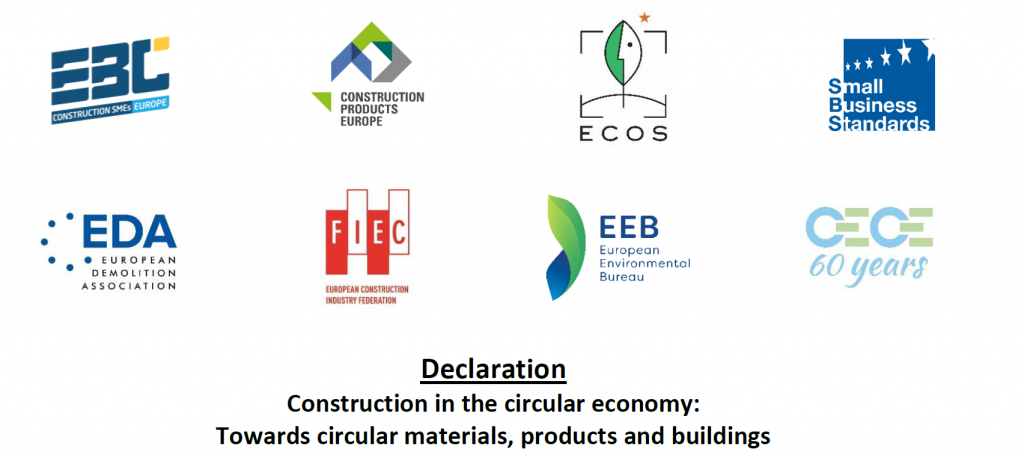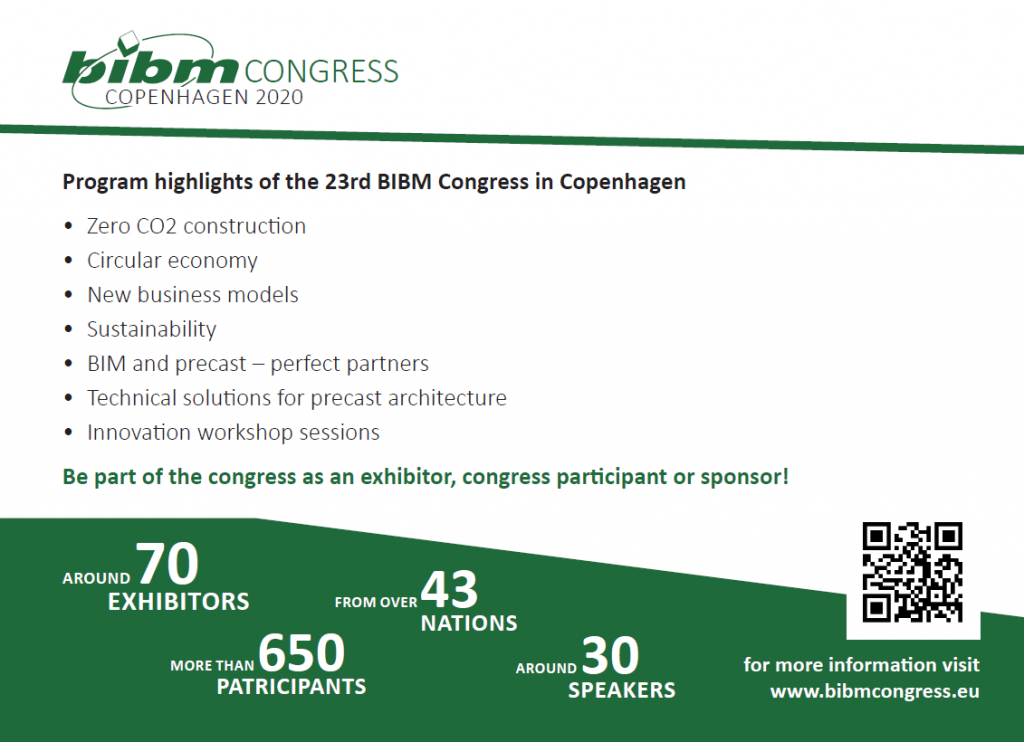Concrete Perspectives May 2019
CONCRETE NEWS
SeRaMCo (Secondary Raw Materials for Concrete) meeting, Fernelmont (BE)
To make the most out of the available resources, SeRaMCo aims to replace primary raw materials with the high-quality materials recycled from Construction and Demolition Wastes (CDW), e.g. concrete, bricks, tiles and ceramics (CBTC), in production of the cement and concrete products for use in North Western Europe.
To attain this goal, the project will:
- Analyse and improve sorting of CDW, as a precondition for successful recycling;
- Develop and test new concrete mixes and technologies for the production of concrete precast products (CPPs) made from the recycled CBTC;
- Establish a market niche for CPPs, leading to the economic advantages for the CPP producers and generating new jobs in the construction sector.
SeRaMCo’s expected outputs are cement and CPPs from up to 100% recycled aggregates, comparable to conventional products both in terms of costs and quality, and ready for commercialization in NWE.
Participants were welcomed in the office of Tradecowall in Fernelmont (Belgium) on 6-7 May where project partners presented their work showing the work summary of the last period of the project and near future.
Ten precast concrete elements were identified as possible testing products for the use of recycled aggregates, from very standard products to innovative concepts.
On the second day, all project partners visited the recycling plant of the wet process and saw the recycling process for the construction and demolition waste from the beginning to the end where the recycled aggregates and sands are washed and separated to different sizes.
During the Steering Committee meeting the milestones of the project were discussed:
- End of 2020: Roughly 5% of the concrete CPP producers use in their production ends up as waste. By reusing this percentage into the production of new concrete, the need for primary aggregates is reduced by up to 5%, and the costs for landfill of his production remains are avoided. When the origin of concrete waste is known, the recovered material is rather homogeneous and available directly on the production site, the hurdles for using concrete remains as secondary raw material are lower than with foreign material of unknown origin. However, CPP producers have to make investments. In order to support these, public procurement should favour CPPs using secondary raw materials in their tenders.
- end of 2025 (mid-term): Demolition with precedes new constructions in European cities generates enormous quantities of CDW which are difficult to recycle and re-use on-site because of missing space. Specialized CDW recycling facilities which produce secondary raw materials for nearby (precast) concrete plants can reduce the traffic of heavy materials on highly frequented urban roads. CDW is carried to the recycling centre and its output material used for the production of CPPs which are taken back on the way to the construction site. Since the combined recycling and manufacturing plant is in the vicinity of the city, transport distances will be much lower than nowadays. However, major structural investments into cutting-edge recycling technologies but also innovation regarding CDW material audits are a prerequisite to make this major shift in the use of mineral construction materials happen. Public procurement will play a decisive role.
- end of 2030: there is going to be integrated recycling and concrete precast production facilities located nearby urban centres and buildings conceived as material banks. Secondary raw materials of diverse quality and origin will be identified and classified through demolition audits and material passports. As a consequence, Other countries outside Europe will implement a circular model in response to an increase in construction demand.
SBE19 – Sustainable Built Environment Conference, Helsinki (FI)
The SBE19 Helsinki edition in 22-24 May debated on how our Clean Planet with its Happy People can share Prosperity for present and future generations. Emerging Concepts ranged from climate change mitigation and adaptation, circularity, net positive approach and ecological handprint, healthy indoor and outdoor environments, business models for value and risk optimization and nature-based solutions to frugal innovation. Accepted Scientific papers were published in IOP Conference Series: Earth and Environmental Science and Industry papers in the Conference Proceedings with ISBN and ISSN numbers.
In particular, the topic of precast concrete has been tackled in the following sessions:
- Interaction of obligatory regulations and voluntary ecolabels for climate change mitigation in the Finnish building sector
- Resource strategies – discussions on remodelling modernistic housing and related social impacts
- The role and value of local welfare institutions in multicultural areas
- Thermal comfort analysis of a representative multi-story social housing unit with wood as an alternative construction material in Brazil
- Circular Economy in the Built Environment: Supporting Emerging Concepts
International Prestressed hollow core Association (IPHA) annual meeting, Sonderborg (DK)
IPHA is the international association of prestressed hollow core manufacturers, active in e in research and development, with regular conferences and seminars enabling the exchange of information between members.
During the annual meeting in Sonderborg on 23-26 May, hosted by Contiga Tinglev, members could spend time together coupling factory visit, interesting talking on the future of the industry and more informal moments. Key topics of the seminar were the future of our cities, the digital transformation in the construction sector and the role of hollow core in a circular construction business.
BIBM joined
the conference to present the BIBM Congress 2020, that will be organised in
Copenhagen on 6-8 May in cooperation with IPHA itself. By putting together the
strengths of our two associations, we aim at organising a successful and
memorable congress next year!
BIBM NEWS
BIBM Congress – One year ahead
You can find more information on the 2020 BIBM Congress here.
We confide in your help to raise awareness within your clients and stakeholders, through organising “national” visits, providing possible exhibitors and sharing the available promotional material.
REGISTRATION DEADLINES:
Early bird tickets for exhibitors: 30th June 2019
Finalisation of program: end of summer 2019
Opening of the registration for participants: end of summer 2019
BIBM Communication Commission, Copenhagen 2 May
The communication strategies for the following topics have been discussed: digitalisation, urban transformation and renewables, precast concrete in urban transformations and Concrete strategy/vision on “decarbonised” construction 2050.
The main topic of discussion was the organisation of the BIBM Congress 2020. All BIBM members are encouraged to actively sponsor the Congress and to reach to possible exhibitors. Currently the available materials for promotion are save-the-date postcards, exhibitor information and the BIBM Congress Website. The channels for advertisement are members’ websites (possibly on the homepage), newsletters and magazines. In particular we thank Denmark for its contribution in „Dansk Beton“, Norway in “Architecture magazine” and Sweden in “Concrete magazine”.
BIBM JUNE AGENDA
3-4: BIBM
General Assembly
Stuttgart
5: Industry4Europe
Working Group on Internal Market
Brussels
6: NEPSI
Technical Committee (Good practices guide)
Brussels
7: Industry4Europe
Working Group on Business-Friendly Environment
Brussels
11: REACH Alliance
Meeting
Brussels
18: EUSEW19
Networking Village, VEEP stand
Brussels
18: Construction Pproducts Europe
CPR working group
Brussels
18: NEPSI
Technical Committee (reporting system)
Brussels
19: EURACTIV
workshop, “European champions vs. hidden champions: What’s the future of European Industry?”
Brussels
19: Construction Products Europe
General Assembly
Brussels
25: European Concrete Platform
Board Meeting
Brussels
26-28: CEN/TC 104
SC1 and plenary
Brussels
BIBM PARTNERS NEWS
CONSTRUCTION PRODUCTS EUROPE

9th of May: Construction Products Europe Manifesto 2019
- Deliver a material-neutral built environment strategy
- Invest in affordable housing and resilient infrastructure
- Develop skilled labour
27th of May: Joint declaration circular economy

- What are European institutions and industry doing to support the uptake of recycled/reused materials?
- How can we make circular economy a reality in the construction sector?
LIVE FROM THE EUROPEAN UNION
- The European Commission recently published a new papertitled Europe in May 2019: Preparing for a more united, stronger and more democratic Union in an increasingly uncertain world, this Communication (which you can download here) is presented by the Commission as its “contribution to the EU’s Strategic Agenda for 2019-2024” with a series of “policy recommendations on the future shape of Europe”.
You can have a look at the second chapter entitled “Competitive Europe” where the Commission explains that “we need to prepare our technological and industrial future in a more strategic way. A modern industrial policy will provide the necessary infrastructure, incentivise innovation, facilitate the uptake of new technologies, foster a smart regulatory ecosystem, and support industry at large. It would build on the single market and focus on strategic value chains, such as manufacturing sustainable batteries in Europe. As part of this, we should be ready to take immediate action if internal or external competitors distort the level playing field. The EU should develop new tools to address the distortive effects of foreign state ownership and support”.
- The Council adopted on the 28th of May Conclusions on “EU Industrial policy strategy: a vision for 2030”. Interestingly, the Council reiterates the calls by the EU Council and the Commission, supported by the EU industry, for a comprehensive and long-term EU industrial policy strategy with a clear vision for 2030, highlighting the opportunities and addressing the challenges for the European industry, touching upon all relevant policy areas, accompanied by a specific action plan including concrete measures and a timetable for implementation and monitoring mechanisms”. Furthermore, the Council states that this “strategy should become a top priority for the strategic agenda of the next Commission and be put in place at the beginning of the new EU institutional cycle” while “strongly encouraging the Commission to elaborate this strategy, which should include policy targets and indicators, in close consultation with Member States and all stakeholders”
- A few weeks prior their EU Presidency, the Finnish Ministry of Economic Affairs and Employment released a publication which is “intended as a basis for the new strategic priorities of the EU and for the work program to be agreed for the next EU Commission to be appointed in November 2019”. The Finnish Authorities call for a “modern industrial policy”. According to them “the EU needs a strategic blueprint and an ambitious action plan interlinking industrial and single market policies to boost the competitiveness of the EU economy”.


